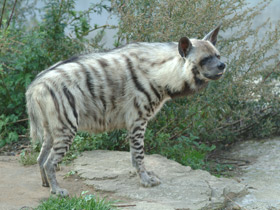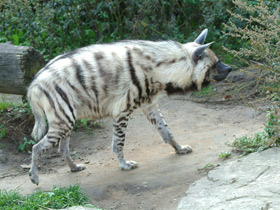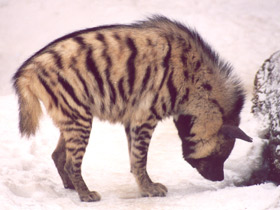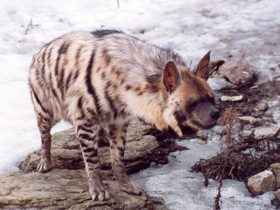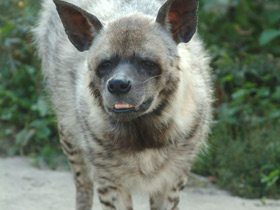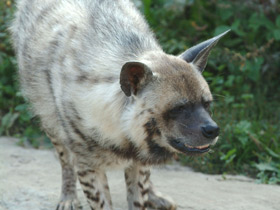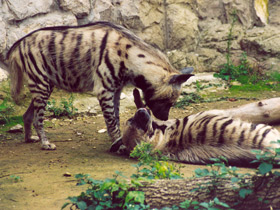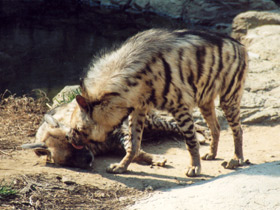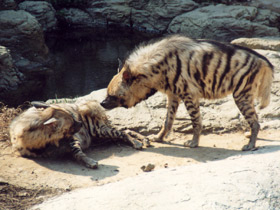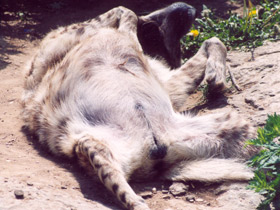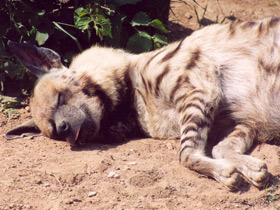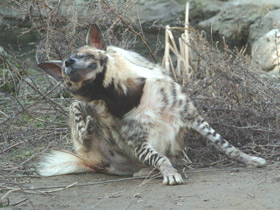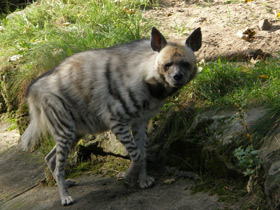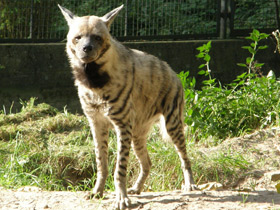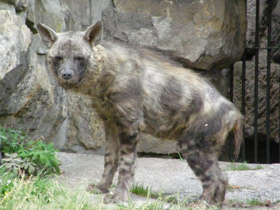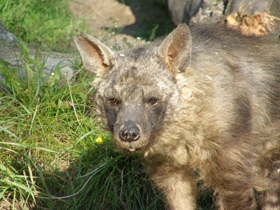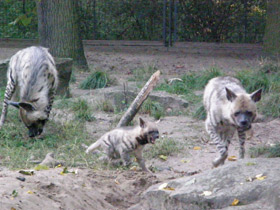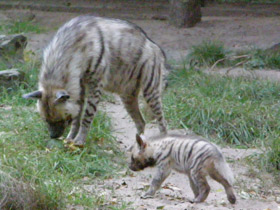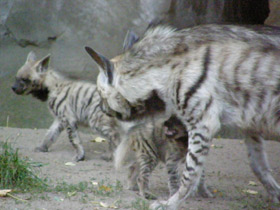The striped hyena (Hyaena hyaena)
Striped hyena видео
The striped hyena (Hyaena hyaena) is a species of hyena native to North and East Africa, the Middle East, the Caucasus, Central Asia, and the Indian subcontinent. It is the only extant species in the genus Hyaena. It is listed by the IUCN as near-threatened, as the global population is estimated to be under 10,000 mature individuals which continues to experience deliberate and incidental persecution along with a decrease in its prey base such that it may come close to meeting a continuing decline of 10% over the next three generations.
It is the smallest of the bone-cracking hyenas and retains many primitive viverrid-like characteristics lost in larger species, having a smaller and less specialised skull. Though primarily a scavenger, large specimens have been known to kill their own prey, and attacks on humans have occurred in rare instances. The striped hyena is a monogamous animal, with both males and females assisting one another in raising their cubs. A nocturnal animal, the striped hyena typically only emerges in complete darkness, and is quick to return to its lair before sunrise. Although it has a habit of feigning death when attacked, it has been known to stand its ground against larger predators in disputes over food.
The striped hyena features prominently in Middle Eastern and Asian folklore. In some areas, its body parts are considered magical, and are used as charms or talismans. It is mentioned in the Hebrew Bible, where it is referred to as tzebua or zevoa, though it is absent in some Bible translations into English. Ancient Greeks knew it as γλάνος (glános) and ύαινα (húaina) and were familiar with it from the Aegean coast of Asia Minor. The striped hyena is the national animal of Lebanon.
Habitat area
Hyaena hyaena is a species of carnivorous mammal in the family Hyaenidae. It is one of the most widespread members of its family.
Hyaena hyaena is found throughout North Africa, in much of Asia from the Mediterranean Sea to the Bay of Bengal, it is also common in northwest and central India, as well as in all countries further east; in sub-Saharan Africa it is also common in some places, but becomes rare towards the south of the region. Interestingly, the range of Hyaena hyaena hardly overlaps with that of the spotted hyena. In the former USSR, Hyaena hyaena is found in Turkmenistan, Tajikistan and Transcaucasia, but is very rare everywhere else.
It prefers foothills with dry stream beds, ravines, gullies, rocky gorges and mazes of caves; it often lives in low, clayey uplands with desert and steppe vegetation covered with pistachio and juniper in some areas; sometimes it is found in sandy desert, but in these cases there must be a water source within 10 km. Hyaena hyaena prefers sparsely populated uninhabited areas, but occasionally visits orchards, vineyards and melon orchards.
Hyaena hyaena does not occur in areas with persistent snow cover and tolerates high humidity poorly. Hyaena hyaena is predominantly nocturnal, but is occasionally active during the day. Unlike the spotted hyena, it does not form herds.
Appearance
Hyaena hyaena is quite large, reaching about 80 cm at the withers, and males weigh 60 kg (exceptionally 90 cm and 70 kg respectively), but are usually much smaller. The height of the rather short front part of the body is accentuated by a thick, stiff mane of hair up to 30 cm in length, while the other parts of the body do not exceed 7 cm.
The legs of the Hyaena hyaena are strong, curved, the front part longer than the hind part, and the back line is strongly lowered towards the rump. When walking, the Hyaena hyaena lowers its hindquarters even further, as if it were dragging them. The neck of the hyena is short and powerful; the head is massive, with a heavy lower jaw and large, broad, pointed ears. The strongly developed chewing muscles are striking, making the skull appear very broad. The teeth are exceptionally strong, capable of tearing even the largest bones; the canines are large. The voice of the Hyaena hyaena is rarely heard. It is mainly a variety of grunts, growls and a coarse hoarse howl, not at all like the familiar "howl" of the Hyaena hyaena.
Nutrition
For the most part, Hyaena hyaena hyaena feeds on carrion and often must make do with the bare skeletons of ungulates gnawed by other scavengers; its powerful jaws, which help Hyaena hyaena hyaena to easily gnaw through any bone, are useful in this case.
Hyaena hyaena is almost omnivorous; it catches all kinds of animals it can catch, eats insects and destroys bird nests on the ground. In spring, in Central Asia and Transcaucasia, the hyena almost completely overtakes turtles when they hatch from their eggs. Even the shell of a large tortoise is no problem for its teeth. In addition, the hyena can pick up remains.
Hyaena hyaena readily eats many types of succulent plants, but is especially fond of melons and watermelon, for which it raids pumpkins; it also eats nuts and seeds. When full, they often sleep near the feeding area or drag their prey to their den and eat it there. The hyena's den is very sloppy and often littered with food scraps and bone fragments. A strong putrid odour can be smelled from a great distance from the dwelling of the Hyaena hyaena.
Social behaviour and reproduction
A Hyaena hyaena calf usually has 2-4 blind offspring that regain their sight within a week or so; both parents appear to be involved in rearing them. Young hyenas reach sexual maturity at 3-4 years of age. Families of Hyaena hyaena exist for several years and consist of one male, one female and one or two, rarely three adult offspring that remain with their parents for at least a year. Within the family, hyenas show a sociability and friendliness that is unusual for them in their interactions with other animals. A family may live in isolation from conspecifics, but also two or three families may live close to each other and each family has several "settlements" (the most intensively used part of the family's living area: several dens, "refectory", "toilet", dust baths, lairs and places to spend the night). The size of a "camp" can range from 50 to 2,000 square metres, while the size of the entire family dwelling is 40 to 70 square kilometres. The spatial relationships of individuals are regulated and determined by vocalisation and scent marking.

















